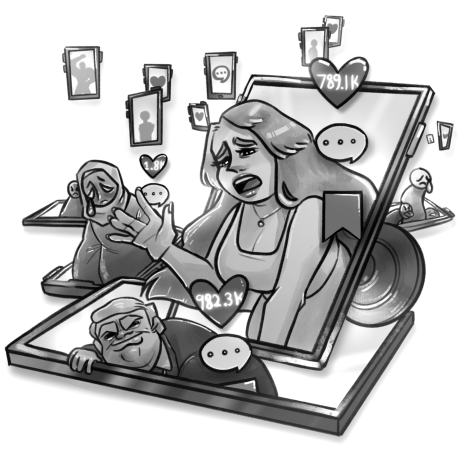Meet the TikTok trend that gets off on your pain
February 16, 2023

Advocacy or retraumatization? That’s the question I find myself asking whenever TikTok recommends me a video tagged “#corecore.” Corecore is a recent trend that takes a third person perspective on human internet involvement and existence, essentially creating a series of jump-cuts with the intention to elicit feelings of profundity in the midst of the “human experience.”
The term corecore itself implies that its goal is to create an aesthetic out of the lives of humans that have already been aestheticized (i.e. all the other internet-spawned “cores,” like “cottage-core,” “goblin-core,” etc). The videos take on an intentionally intense and overwhelming form, moving quickly through vast quantities of extremely varied subject matter, showing at once clips of things like natural disasters, newscasters, makeup tutorials, or comedy sketches, often accompanied by melodic, melancholy music in an attempt to rouse introspection.
However, there is a subgenre of the corecore trend that has begun to emerge recently; this subgenre is one that takes the violent and rampant presence of misogyny on the internet and places it within the “aesthetic” of corecore. The goal is undeclared by the creators of the content, but the common interpretation is that these videos exist to draw attention to the pain that women endure and how ever-present it is within the framework of internet comment sections.
These “feminist” corecore videos are alarming and frightening, however, in their failure to enact positive change. The comment sections on these trauma-montages are often a replication of the very rhetoric the TikTok creator was attempting (perhaps) to combat; men bending over backward to declare their allegiance and agreement with the grossly sexualized statements (disturbingly frequently about young girls) that flash by across their screens. Terms like “sigma male” that originated as jokes begin to cast larger shadows in the hands of men who likely align themselves with people like Andrew Tate in elevated written displays of sexual violence.
To a skeptical viewer, these videos seem to have a clear purpose. They are so ineffectual at change-making that they appear only to exist to garner views and likes for their creators. The retraumatization that women face when they see these videos and are forced to reckon with the near-constant harassment they face in their lives begins to feel like one of many evils of “feminist corecore.”
Troublingly, a great deal of the traits of these videos reinforce suspicion that they are merely another brick in the great historical precedent of creating exploitative shock value out of predatory trauma, and in the process, creating a mass-minimization of empathy by aestheticizing this pain. TikTok is not a platform for earnest human connection, and it is therefore no place for a successful campaign against internet over-sexualization – or anything, for that matter.
However, the vast majority of this type of corecore content is made by women. This complicates the narrative that this is pure exploitation, though it remains a concerning movement in a misguided forum. The presence of women visually displaying instances of their own harassment begins to add a degree of nuance to “feminist corecore,” and another set of questions arises: “Does aestheticizing one’s own pain help to mitigate it? If so, is it worth it when misogynists will flock to these attempts at pain-expression and cause more?” Corecore is such a relatively new trend that these questions have yet to be answered, but the continuation of this subtrend at all by female creators speaks volumes.
There is another tendency in some of these videos; they begin to approach the issue of the indirect violence of weighty social pressures and beauty standards on women, displaying the effect rather than the cause (i.e. clips of women discussing absurd beauty trends like straws that “don’t cause lip wrinkles,” etc). This is clearly yet another way for women to express internal angst about the condition of womanhood on the internet. Does this foster a sharing of pain, or does it merely ostracize the women who have fallen for these hyper-specific beauty trends under the weight of expectation and standard?
One way or another, “feminist corecore” is the latest online method for women to express the pain that they endure in their lives and possibly seek a community. I believe that this trend is dangerous for the integrity of female pain and veers concerningly close to normalizing the aestheticization of it. The trend is taken to a degree that will surpass what is helpful for mediating suffering and enter the realm of minimization. Only time will tell how this trend will evolve, but as it stands at this moment in our internet-landscape, we should be hesitant to suspend our skepticism.





